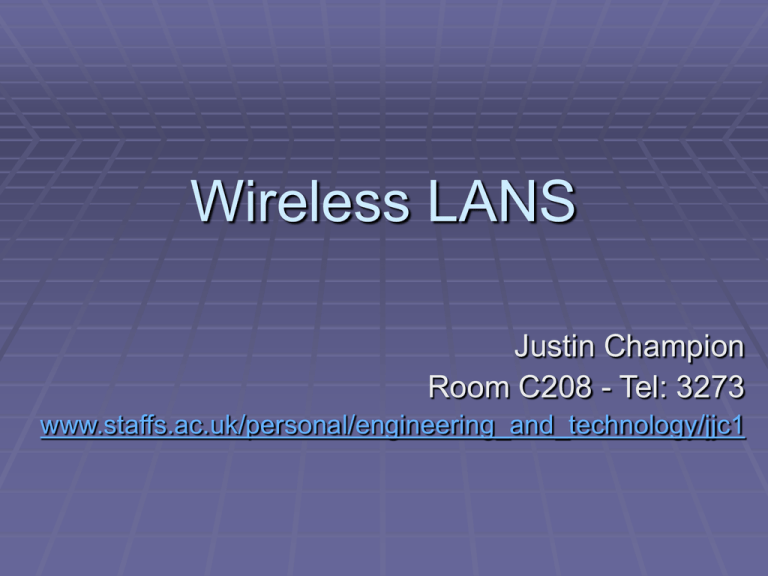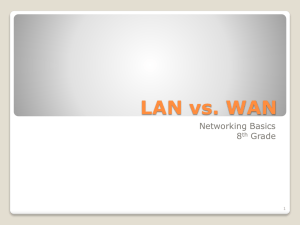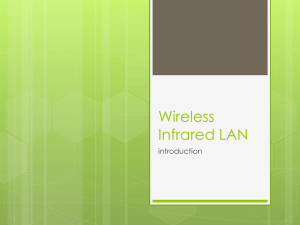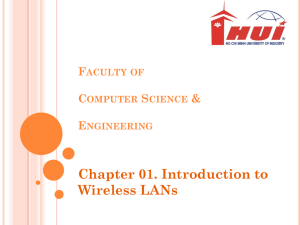PowerPoint Presentation - Staffordshire University
advertisement

Wireless LANS Justin Champion Room C208 - Tel: 3273 www.staffs.ac.uk/personal/engineering_and_technology/jjc1 Wireless LANS Contents What is a LAN Types of wireless LAN AdHoc Infrastructured Infrared Communications Uses of these technologies Wireless LANS What is a LAN There are two main types of network infrastructures Local Area Network (LAN) Wide Area Network (WAN) The classification for these types of networks is the distance that the data has to travel There is no exact formula to classify when a LAN becomes a WAN in a wired network! Consider Staffordshire university is the email server part of a WAN as it is located in Stoke? Or a LAN as it is all one network Wireless LANS LAN The network in this campus is a example of a LAN All machines are attached and located close to each other Distance in network terms is classified by the number of hops travelled between one device and another Hops are the stages that information has to travel through to get to the destination. Wireless LANS LAN Within a wireless network this is easier There is a physical limit to any wireless LAN technology. Bluetooth – 10 Metres Infrared – 1 metre After these physical limits The Bit Error Rate (BER) becomes too high for realistic communications to take place The BER indicates what percentage of bits sent arrive at the destination in error Wireless LANS Types of networks In wired networks there is always an infrastructure Even if two people bring together laptops for a game, there will be a cable and a device to repeat the signal A Hub, Router or Switch on Ethernet Wireless This may not be the case The devices may only be able to communicate for a few seconds and then they are out of range People may come together for a meeting and then move away again Wireless LANS Types of networks AD-HOC No pre planning of the network takes place Communications may happen for hours or seconds Using the Nokia N-Game with friends is an example of this Business men in a meeting exchanging data Difficulty in routing data to these devices Infrastructured The network has been planned The structure would not change A office would be a good example of this Wireless LANS Ad-Hoc These networks work as the devices come within the transmission distance of each other When these devices can be used to extend a network In this diagram device B can not reach the printer Printer Device B Device A Wireless LANS Ad-Hoc One device can be used to reach the device you actually require The packet is sent from device B to A and then to the printer Device A Printer Device B Wireless LANS Ad-Hoc These networks are an active research area The technology works now The difficulty is working out a route through the network The route change all of the time Each time a packet is sent to sort out a route this takes battery power on all devices With enough devices nothing but routing information will be sent Ad-Hoc protocol Mobile Ad-hoc Networks (MANET) This group is standardising the IP routing protocols (www.ietf.org/html.charters/manet-charter.html) Wireless LANS Infrastructure This would be used to supplement the current network This allows for laptops Reduces the amount of cables This reduces infrastructure costs Allows workers to operate where they want in the building Usually combined with wired infrastructure Examples would be central high power printers Planning is required Remember that a radio signal from one device is just interfering noise to another device The more interfering devices the less successful communications that can take place Wireless LANS Infrastructure Planning is required to minimise the amount of interference This can be done by increasing the distance between high users of a system Different rooms for the devices Some building materials will dampen the signal Staffordshire University Octagon is an example of this kind building Wireless LANS The Technologies Wireless LANS Before we start on this course clarification of a widely used term the “Packet” All data which is transported on a network (wired or wireless) is broken into smaller parts These parts are referred to as packets Each packet is then sent to the recipient The packets are then reassembled into the original data Packets usually consist of Control information The data which is being transported A checksum to ensure the packet is not corrupted Wireless LANS Infrared Large installation base Most devices install these ports Phones Laptops Printers Not widely used! Question becomes why? Standards defined By Infrared Data Association (IRDA) www.irda.org Wireless LANS Infrared – Operates by line of sight Wireless LANS Infrared The data is encoded into pulses of Infrared (IR) light Your television remote control works in the same manner Technology is suited to Short distances with all devices within a room It is purposely designed to operate at about 1 meter This give IR security built in in respect that no one can ‘listen’ to that conversion Data Rates Although IR is considered to be a slow technology it is developing Serial IR – 115.2 Kbps Medium ID – 1.152 Mbps Rarely Used Fast IR – 4 Mbps Latest phones, cameras, etc support this standard Very Fast IR – 16 Mbps Microsoft Windows XP supported only Wireless LANS Infrared Advantage of the line of sight problem is that the communications are not shared The devices need to be within a 300 arc of each other Once the receiver and sender have agreed a transmission speed very little can interfere with this This reduces the overhead on communications Collisions do not need detecting Secure communications layer does not need adding Wireless LANS What is a Stack? The term stack refers to the Open System Interconnection (OSI) Stack This is a network standard that defines what communications should take at which stage There are 7 layers to the stack as shown below Each layer carries out a specific task Each layer can only communicate to the layer above or below All other network protocols map to this stack Application Not all layers are used with every protocol Presentation Session Transport Network Data Link Physical Wireless LANS Communication between devices using the stack Packet of information going from device 1 to device 2 Device 1 Application Presentation Session Transport Network Data Link Physical Logically Device 2 Application Presentation Session Transport Network Data Link Physical Wireless LANS Infrared Communication Stack Only the layer above and below can communicate with a point in the stack irLAN OBEX irCOMM IAS TinyTP irLMP Optional Required irLAP Physical Wireless LANS Physical Defines encoding/decoding of data and transmission of the signal IRLAP Link Access Protocol Responsible for ensuring a reliable transport of data IRLMP Link Management Protocol Multiplexes services and application together to use the one connection for transport IAS Information Access Service Allows knowledge of the capabilities/services of the device Wireless LANS Optional uses of IR TinyTP This is a version of transport protocol designed specifically for IR Flow control is offered ensuring that device buffers do not overflow Maximum packet sizes are agreed by devices Large packets can be broken into smaller parts irOBEX Object exchange protocol Allows transfer of files easily between devices irCOMM Allows emulation of serial and parallel ports The applications do not need to know that they are using IR Legacy applications will work with this a printer is an example irLAN Allows LAN access for the devices Mainly used to allow LAN access through a device which is already connected to the network Wireless LANS So why is not widely used Although newer versions of the technology are fast the image is still for a slow technology Sun light The sun gives off IR and as such in bright light this will effect the operation Makes operation in the open awkward Positioning The devices need to be in line of sight, which means that they need moving from there normal position The distance between the devices can effect the rate of transfer Too close can be as bad as too far! Wireless LANS Summary What is a LAN OSI Stack Packet Infrared communications








